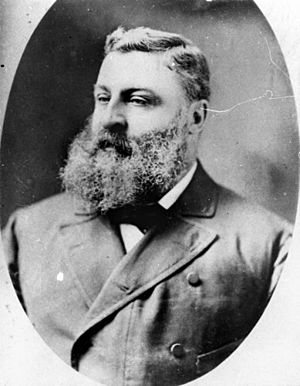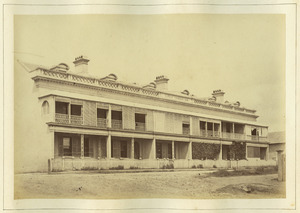Harris Terrace, Brisbane facts for kids
Quick facts for kids Harris Terrace |
|
|---|---|

Harris Terrace, 2007
|
|
| Location | 68 George Street, Brisbane City, City of Brisbane, Queensland, Australia |
| Design period | 1840s - 1860s (mid-19th century) |
| Built | c. 1866 - c. 1867 |
| Built for | George Harris |
| Architect | J & G Cowlishaw |
| Architectural style(s) | Georgian |
| Official name: Harris Terrace, Harris Court | |
| Type | state heritage (built) |
| Designated | 21 October 1992 |
| Reference no. | 600121 |
| Significant components | attic, residential accommodation - terrace house/terrace, residential accommodation - servants' quarters |
| Builders | Mr Clarke |
| Lua error in Module:Location_map at line 420: attempt to index field 'wikibase' (a nil value). | |
Harris Terrace is a special heritage-listed building in Brisbane City, Queensland, Australia. It's a row of six attached houses, like townhouses, that were built a long time ago. An architect named J & G Cowlishaw designed them, and they were finished around 1866-1867. Today, Harris Terrace is recognized as an important historical site.
Contents
The Story of Harris Terrace
Harris Terrace is a two-story building made of stone or brick. It used to be six homes connected together. It was built in the mid-1860s for a man named George Harris. The famous architect James Cowlishaw designed it.
Brisbane's Early Days
Since the 1820s, the area near the Brisbane River where George Street is now, has been important for government activities. When Brisbane was a prison colony, buildings were put up for officials. Later, when people could settle freely in 1842, these old buildings helped decide how the new town would be laid out. George Street, where Harris Terrace stands, became part of Brisbane's main street plan.
Why George Street Was Important
Even after Brisbane became a free settlement, the government kept a strong presence in George and William Streets. After Queensland became its own state in 1859, the new government built many important buildings here. For example, the first Government House and Parliament House were built nearby in the 1860s. This made the area a central spot for government.
Many early politicians were wealthy farmers. They, along with government workers, needed places to stay when they were in Brisbane. So, from the 1860s to the 1880s, many buildings were constructed in this area, often by or for politicians, to provide homes.
Who Was George Harris?
Harris Terrace was built as an investment by George Harris. He was born in London in 1831 and came to Brisbane in 1848. He became a successful merchant, importing goods and exporting wool. George Harris was a well-known person in Brisbane business and society. After Queensland became a separate state, he was chosen to be a member of the first Queensland Legislative Council. This was a group of important people who helped make laws for the new state.
The early 1860s were a time of fast growth for Brisbane. Many new public and private buildings were constructed. A law in 1864 also encouraged buildings to be made of brick or stone with fireproof roofs. This made buildings like Harris Terrace more permanent.
Building Harris Terrace
In 1865, George Harris asked architect James Cowlishaw to design a row of six homes. This was on the corner of George and Margaret streets. Cowlishaw was a very respected architect in Brisbane. He had designed other buildings for Harris before.
Terrace houses, or attached houses, were a popular type of home in cities in England. They came to Australia in the early 1800s. While common in Sydney and Melbourne, there were fewer in Brisbane. The ones built in Brisbane were usually in the city center or nearby areas.
A law in 1885, called the "Undue Subdivision of Land Prevention Act," made it harder to build terrace houses in Queensland. This law set a minimum size for land plots, which encouraged people to build detached houses instead. Harris Terrace is one of only a few terrace houses from the 1860s that still exist in Brisbane today.
Cowlishaw first asked for builders for Harris Terrace in 1865. The building was completed by a builder named Mr. Clarke. It cost about £8,000. Harris Terrace was ready for people to move in by January 1867. People at the time said it was "substantially built" and had an "imposing exterior." They also said it had everything a good home in England would have, but also suited the warm climate.
When it was finished, Harris Terrace was a two-story brick building with an attic space in the roof. Each of the six houses had living rooms downstairs and bedrooms upstairs and in the attic. At the back, there were separate two-story buildings for the kitchen, bathroom, and maid's room. The roof was made of slate, and there were windows sticking out of the roof. The building also had a fancy railing on the top with "Harris Terrace 1866" written on it.
Life at Harris Terrace
Many important people lived in Harris Terrace early on. These included politicians like Joshua Bell and Kevin O'Doherty. Some of the houses were also used as girls' schools in 1867. By 1868, Harris Terrace was known as "the best private residences in the city." Doctors and senior government workers also lived there. Each house had its own number, and some even had their own names.
Later, in 1876, George Harris had financial problems. He had to give Harris Terrace to James Taylor, who had lent him money. In 1887, two other politicians, Boyd Morehead and William Pattison, bought the property. They both lived there at the time. The next year, these politicians, along with John Stevenson, built The Mansions. This was another, even fancier, terrace house next to Harris Terrace.
The houses in Harris Terrace continued to be used as homes into the early 1900s. From the mid-1880s, some became boarding houses. By the 1920s, all the houses were used for boarding. In 1922, the Lingley family bought the building and changed its name to "Harris Court." After a law change in 1923, each house could be sold separately. The Lingleys kept one house and turned it into a cafe.
Changes Over the Years
After World War II, the Queensland Government needed more office space in Brisbane. They started buying properties in George and William Streets. Harris Court was bought around this time. Even though the buildings were old, they were quickly used for government offices because there was a shortage of space.
Because Harris Court had existing renters, it wasn't until the mid-1950s that the last people moved out. In 1958, plans were made to change Harris Court for government use. The original kitchen and service buildings at the back were taken down. A new office building was added behind the old one.
Major changes happened to the original building in 1960-61. The balconies and verandahs were removed. A new front was built, connecting the houses. Many front doors were replaced with windows, leaving only two main entrances. Windows were changed, and chimneys were blocked up. The inside of Harris Court was also changed a lot. Some staircases were removed, and walls were taken down to create long hallways for offices.
Saving Old Buildings
In the 1960s and 70s, the government planned to knock down many old buildings in George and William streets to build new office towers. However, many people in the community wanted to save the older buildings. Groups like the National Trust of Queensland argued that these buildings were important for their history and beauty.
A famous event happened in June 1974. The balconies of the Bellevue Hotel, which was across from Parliament House, were suddenly removed by the government. This made people even more determined to protect old buildings.
In 1979, the government decided to demolish the Bellevue Hotel but to keep and renovate The Mansions and the original part of Harris Court. The Bellevue Hotel was knocked down very early in the morning on April 21, 1979. This was a sad day for heritage protection in Queensland.
Harris Court and The Mansions were kept as part of a new government building project. As part of this project, Harris Terrace was renovated and rebuilt. The ground floor verandah and upper floor balcony were put back, looking similar to the originals. A new slate roof was added, and some front doors and windows were put back. The building was also given its original name, "Harris Terrace," again.
Since then, only small changes have been made. Today, Harris Terrace provides office spaces for different community groups.
What Does Harris Terrace Look Like?
Harris Terrace is a row of six brick, two-story attached houses. It's located on the corner of George and Margaret streets in the government area.
The front of the building has a two-story verandah. This verandah has decorative iron railings and posts. It is divided into six sections, showing where the original six houses were. Each section has three tall French doors on the first floor. On the ground floor, there are two sash windows and a front door for each house.
At the very top, there's a central plaque with the building's name and the year it was built. The tiled roof has six chimneys and dormer windows with rounded roofs. The verandah roof is made of corrugated iron.
At the back, there are four short, two-story sections that create small courtyards. The windows on the first floor of these sections have round arches. The windows at the back of the main building have flat arches. The roof windows have rounded tops, and the back sections have pointed roofs.
Inside, the building has modern offices. These offices open onto a long hallway that runs through the middle of the building.
Why is Harris Terrace Special?
Harris Terrace was added to the Queensland Heritage Register on 21 October 1992. It's considered important for several reasons:
- It shows how Queensland's history has changed. Harris Terrace is a rare example of terrace housing from the 1860s. It helps us understand how homes were built in Brisbane a long time ago. It also shows how George Street became an important residential area because of all the government activity nearby.
- It's a rare and special building. As one of only three terrace house buildings from the 1860s that still exist, Harris Terrace is very uncommon. It's also one of the few remaining buildings from the 1860s in Brisbane City.
- It could teach us more about history. The area behind Harris Terrace might still have hidden clues, like the foundations of the old service buildings. Digging there could uncover old items like glass, pottery, and bones. These items could tell us more about how people lived and worked there in the past.
- It's beautiful and important to the area. Harris Terrace has a grand and impressive front. It's a key part of George Street, which has many beautiful buildings from the late 1800s. It also adds a lot to the overall look of the government area between George Street and the Brisbane River.



